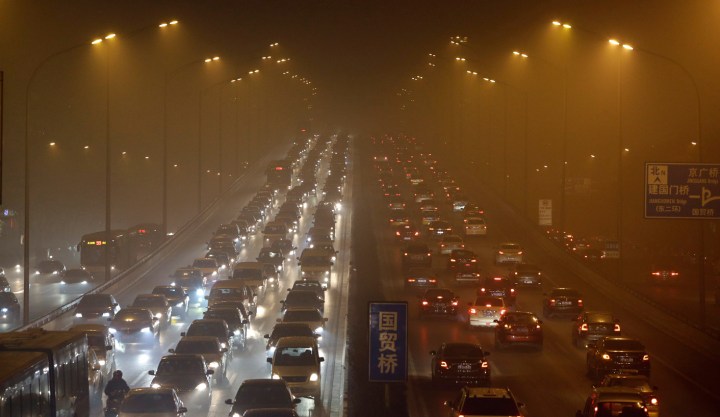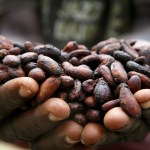World
Choke on it: China’s deadly pollution problem

What does it feel like to live in a country growing roughly 10% year on year? Right now, the Chinese would say that it doesn’t feel so hot. For those of us in the Middle Kingdom, hunched beneath the grey of an unending pollution cloud, the price of development feels very high indeed. By RICHARD POPLAK.
When in doubt, a schoolteacher once told me, turn to Dickens. And so, under a cloud of smog so enormous and persistent that it threatens to obliterate the memory of sunshine, I dig through Great Expectations: “The shameful place,” said Pip, describing Smithfield, Victorian London’s meat market, “being all asmear with fat and blood and foam, seemed to stick to me.”
It’s the “foam” in that quote that has clung to my memory after all these years. What, one wonders, could possibly be foaming in industrial age abattoir? Do we really want to know? So it goes in 21st Century China, the country that acts as the planet’s bottomless credit card – massive annual GDP growth nursing the developed world through a bunch of self-inflicted credit crises. What exactly lurks in the air that makes it lethal to unborn children and the aged, and every living creature in between?
Just about everything, is the short answer. At the beginning of last year, no doubt in an effort to start softening up the population for a raft of necessary but costly anti-pollution measures, Beijing began publishing the density levels of PM 2.5 – particles of 2.5 microns or smaller that can damage the lungs. Safe daily levels are about 25 micrograms per cubic metre. Currently in Beijing, the PM 2.5 density is at around 900. Put that in your pipe and smoke it.
Indeed, one of the jokes doing the rounds is that it’s now healthier to suck back a box of Marlboro’s than it is to go for a jog. (Not that you’d want to in -6°C.) A cold front is moving in, and by late Tuesday things were expected to clear up somewhat. But it is now more obvious than ever that the capital and the environs are suffering from a pollution problem that can effect the economic, and therefore the social, stability of the country.
“Pollution may make economy splutter,” screeched the China Daily on Tuesday. Fifty-eight factories around the city were shut down on Monday after failing emissions tests, and work at construction sites that was kicking up dust was also suspended. Down the proverbial road, in Shijiazhuang, workers at more than 700 construction sites were asked to put their bulldozers in park, and take a few days off.
Government officials have been hastily organising press conferences in order to show how much they’ve been doing to deal with the problem, which is by no means restricted to Beijing. As far west as Chongqing, where I was currently working on assignment, the same gruesome, noisome cloud dominated the skyline. In Chongqing’s case, fog is the predominant theme of winter – but even there, the pollution indices were set at DEFCON 1.
The problem is being blamed on coal power plants and vehicle emissions, with the construction industry running up a close third. Cold weather, followed by a brief warmer spell, has trapped the gunk low in the atmosphere, where it broods patiently. And while pollution and China may seem old hat – think all the handwringing over air quality during the Beijing Olympics, or Edward Burtynsky’s large-scale photographic images – this current bout has the authorities promising action, and warning of the economic consequences thereof.
The resolve has been bolstered by more bad news from the annual China Greenhouse Gas Bulletin, released by the China Meteorological Administration, on Monday. Last year was a record for carbon dioxide levels, which measured 392.2 parts per million, which is the highest since the station opened in 1990. China’s 12th Five Year Plan (2011-2015) plans on cutting carbon emissions by 17% by 2015, which is good news if you’re a fan of planet earth.
But bad air does not mean bad business – not for everyone, at any rate. Sales of air purifiers have been off the charts since the pollution cloud moved in for a lengthy visit. China’s e-commerce sites are almost out of stock—sales are up 700% over the same period in previous years. And the healthcare sub-index of China’s A-share market are up 2.8% since Monday. Energy shares are also up, because investors believe that Beijing has no choice to act forcefully, which could drive up the sales of solar panels, hybrid cars, electric vehicles, and other alterna-energy products. Counter-intuitively, even major energy producers, like PetroChina are enjoying share price boosts of 1.68%.
Meanwhile, almost every CCTV station is running reports on the nasty, persistent cloud, which has become something of a personification of China’s rampant growth. On the streets, the big fashion accessory is a dentist’s mask, which is sort of like wearing a condom to protect against a tsunami. But it does seem like pollution has entered the cultural consciousness in a way that has made the status quo unsustainable, especially for a government that isn’t fond of popular uprisings and picket lines.
That said, China isn’t going to clear up quickly – the country is as addicted to coal-fired power, and nothing in the short term is going to change that. But Beijing’s choking citizens are losing their patience. It’s one thing to read Dickens, or to watch Keira Knightly play all the characters in a Hollywood adaptation. It’s another thing live like the character in a Dickens novel. Pip would have nothing good to say about Beijing today. The place is practically foaming. DM
Photo: Vehicles drive on the Third Ring Road on a very hazy winter day in Beijing January 12, 2013. Microscopic pollutant particles in the air have killed some 8,600 people prematurely in 2012 and cost $1 billion in economic losses in four Chinese cities, according to a study by Beijing University and Greenpeace. The study of pollutant levels of PM2.5, or particles smaller than 2.5 micrometres in diameter, in Beijing, Shanghai, Guangzhou and Xi’an called for PM2.5 levels to be cut to World Health Organisation guidelines, which would reduce deaths by over 80 percent, the China Daily newspaper reported. REUTERS/Jason Lee
















 Become an Insider
Become an Insider